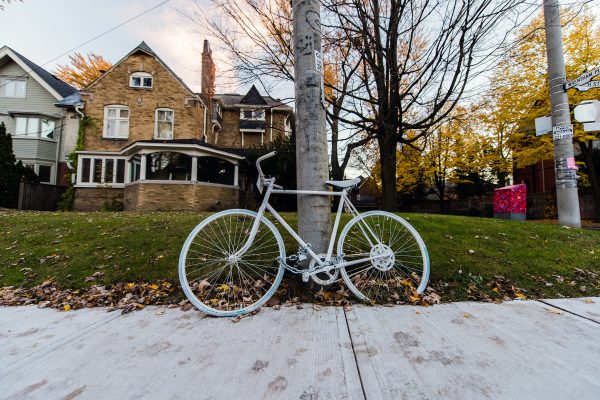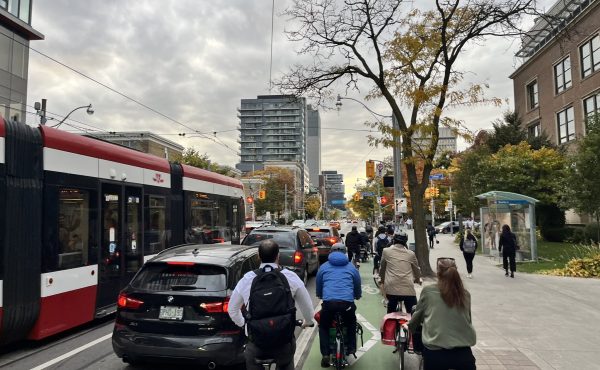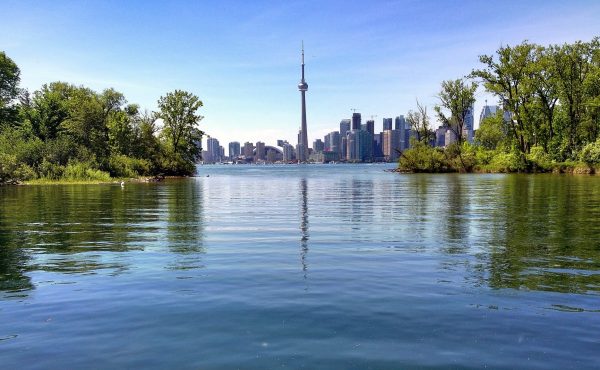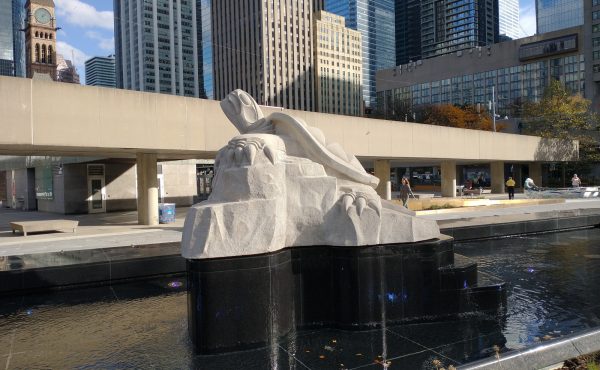LEIPZIG, GERMANY, reporting from the International Transport Forum — The contrast could scarcely be starker: with yet another death last week driving up 2018’s grim toll of pedestrian and cyclist fatalities on Toronto roads, New York City’s deputy transportation commissioner Michael Replogle turned up at the International Transport Forum summit in Leipzig to report the stunning results of a Vision Zero campaign supported by more than just political lip service.
Since Mayor Bill DeBlasio took office in 2014, Replogle says, traffic fatalities have dropped 23% overall, with a bracing 36% reduction in pedestrian deaths. The Big Apple has achieved this turn around despite population growth and a decline in transit ridership caused by both ride-sharing and a maintenance crisis that has inflicted a world of pain on New York subway users.
In Toronto, however, the roster of deaths has steadily grown in the two years since the City and Mayor John Tory adopted our tepid Vision Zero program.
It’s a tale of two cities.
Many Toronto drivers and local politicians go out of their way to block efforts to meaningfully reduce speeds while the City, and the mayor, have continued to send out mixed messages about the need to make roads function more efficiently. (This is not just a Toronto issue. According to OECD road safety rankings released today, Canada saw a 10.5% increase in pedestrian deaths between 2010 and 2016, making it one of only a handful of 30 developed economies to experience a rise in such fatalities. The others include Germany, Australia, the United Kingdom, France, Sweden and the U.S. Norway and Portugal, by contrast, reduced pedestrian deaths by over a third in the same period.)
In the Big Apple, Replogle explains, the Vision Zero policy framework enjoys not only “overwhelming support” from the public, but has been methodically implemented by city transportation officials tasked with turning the political rhetoric into operational reality.
After DeBlasio took office, he immediately ordered the reduction of speed limits on most New York streets from 50 km/h to 40 km/h – a move that sharply cut speeding incidents and is almost certainly the most significant driver behind the fatality reduction figures.
At the same time, New York’s Department of Transportation (DOT) embarked on an extensive data-gathering exercise, compiling so-called “killed or seriously injured” (KSI) stats from especially unsafe streets and intersections, but also consulting with residents to register their experiential knowledge.
From there, Replogle says, the DOT went after what he describes as “low-hanging fruit” – e.g., adding the traffic calming measures that New York has become increasingly renowned for, such as painted pavements, stone treatments, and other visual methods for demarcating pedestrian zones.
The City then obtained state authorization to set up traffic cameras in 140 school zones. Using annual comparison data on how safety has improved or not in those areas, the NY DOT has subsequently shifted those cameras to school zones in greater need of calming.
New York officials have also allocated $1.2 billion — an impressive sum even in a huge municipality like New York — on physically retrofitting streets with bike lanes, wider sidewalk allowances, narrower lanes, and pedestrian plazas. In some cases, such as on Queen’s Boulevard — an especially dangerous thoroughfare in Brooklyn that saw an average of 18 pedestrian deaths per year through the 1990s — there was significant pushback from commuters initially.
Yet Replogle says the DeBlasio administration has mostly resisted vehicular NIMBYism by insisting on calming measures in areas where the evidence clearly indicates excessive risk. Queen’s Boulevard has seen a multi-phase, multi-million-dollar redesign, which consisted of a range of measures including generous pedestrian crossing times, wider curbs, medians, dedicated bus lanes, a reduction of two vehicular lanes, bike lanes and more cross-walks.
The results have been stunning: no deaths in the past three years.
What can we point to? Yes, Bloor and King have been redesigned to provide more space for bikes and streetcars, and less for private vehicles. But there are many more examples of pointless political resistance (e.g. the Yonge Street North re-design) and general backsliding (the freeze on the deployment of more scramble intersections). Has the City done much of anything in improving safety on all those super-wide suburban arterials where pedestrians die quite regularly? Not really.
New York’s story shows that even in a period of rising vehicular traffic, a Vision Zero campaign built on a solid foundation of actual change in road design, rather than the quicksand of rhetoric and half-measures, truly does save lives. “There’s been political blow-back” to some aspects of the Vision Zero plan, Replogle says. But, he hastens to add, the city’s muscular response is that “it has a higher responsibility to protect human lives and there’s really no alternative.”






8 comments
Vision Zero is a joke. It will never be zero so the goal is not practicable. We have had RIDE for decades yet there are STILL people being killed by impaired drivers. Seats belts have been around for decades yet we still have drivers and riders getting killed in wrecks because they are not wearing them.
Cutting speed limits is useless without ENFORCEMENT!
Red light running is rampant everywhere. Nobody stops for right on red. There is only one solution; enforcement. HUNDREDS of red light cameras everywhere.
All of this enforcement will cost nothing since the guilty will pay. BTW it is NOT a fine. It is a voluntary tax. Don’t want to pay it? Obey the law all the time. Simple.
@Raymond that is not true at all. Vision Zero isn’t meant to literally reduce accidents and deaths to absolute zero, but drastically decrease it, which New York has succeeded in doing. And enforcement is exactly what Vision Zero is NOT about. The crux of the philosophy of Vision Zero is that people on the roads will always be on the roads; car drivers will be idiots, cyclists will be idiots and pedestrians will be idiots and not everyone will follow the rules. Vision Zero is supposed to physically change the design of the streets so that it can accommodate bad behaviour such that accidents aren’t able to be physically possible, or, at least, be less fatal.
Vision Zero isn’t about just cutting speed limits. What’s the point of doing that if the road is still the same width? With wide roads, car users will naturally follow the speed that seems comfortable on that roads, which results in so many fatal collisions. Just narrowing some of the streets and using physical traffic calming will help reduce the fatality of these collisions, and naturally slow people down. That’s just one example of what Vision Zero isn’t about. The administration simply hasn’t embarked on the project, and it seems like they just don’t understand the principle behind it. Vision Zero isn’t about rule enforcement, it’s about risk reduction, keeping in mind that people will not always obey the law.
Traffic laws need to apply to cyclists. I am a pedestrian who walks 10km/day through the city. I almost never have issues with drivers. But every single day, on multiple occasions, I encounter people who ride their bicycles through red traffic lights, fail to obey stop signs, ride the wrong way on one-way streets, mount the curb and ride on the sidewalk ringing their bells at pedestrians to get out of their way, cutting of vehicles unsafely, not permitting right turns and backing up traffic, and blasting past bus and streetcar doors at a stop, endangering other peoples lives. I was personally hit twice last summer by cyclists, both times on a sidewalk, once I was seriously injured and made a police report. There needs to be a massive education campaign backed by traffic enforcement and heavy ticketing for infractions. and the price of tickets for cycling infractions needs to go way up.
Maybe the way to deal with this is to delay councillor and council staff pay days. Every time someone is KSId by a motor vehicle, all of city council, and their office staffers have their next payday delayed by a week. Those who work in the ward where it happened can wait two weeks.
Surely that’s a reasonable way to encourage councillors and their political staff to reflect on where their priorities lie. Someone has had their life ruined by a car in the ward you were elected to represent/selected to help a councillor represent. You’ll have to wait a week to get paid.
Thanks for all of this; and yes, we’re kinda world-last in a few ways in Caronto. This is important view:
https://tdaglobalcycling.com/2018/05/i-have-more-fear-cycling-in-toronto-than-anywhere-else-in-the-world/
although cyclists themselves yes, can be a problem to others, including other cyclists. However, to be clear, there are reasons to be ‘out’ and ahead, including avoiding the real tightness of streetcar-tracked roads, and the City still fails to include any falls from these in their stats, so the main east-west roads tend to be worse, and it’s not the fault of the current generation that the Queen St. subway didn’t get built after approval by voters in 1949, or the larger DRL using Front St. in 1985. If we had superior transit like a subway in a logical place, it’d be a great help, and yes, we could think of bike lanes on Queen, or on the Gardiner because transit would be improved.
Meanwhile, it is tempting to penalize the politicians and staff where the KSI occurred, but no, we are dominated by the suburban areas, (eg how only some local roads had speed reductions) and much fairer to do would be to deduct funeral costs etc. from those politicians of the area where the offending driver came from. Most politicians would like to trim traffic in their areas at least.
@Pedestrian
Sounds like a paid troll there. Most of the stuff you wrote about are problems for drivers. I walk through the city everyday and the only people I feel a hazard from are car drivers. I walk through neighborhoods with a high number of kids going to school and people with mobility issues going to the hospital. I see two major 4 way stops with most drivers ignoring the signs. Many times blasting through them. Watch at Yonge and Dundas all the drivers who blast through red lights or try to make illegal turns in the heaviest pedestrianized intersection of Toronto. I don’t care about bikes doing those things because they aren’t going to cause anyone permanent damage. You might get scared but then there gone.
Have you seen the recent video of the car almost hitting people standing on the sidewalk. Did you hear about the car killing people waiting at a bus shelter? Do you want to try some other headlines?
“SUV slams into Little Italy home, causing major structural damage”,
“Someone drove a car into the Queen’s Quay streetcar tunnel again,
“Driver crashes car into TTC stop downtown: police”,
“North York girl, 6, rushed to hospital after being pinned by rolling SUV”,
“Suspected drunk driver smashes into 11 parked cars in auto sales lot”,
“Man, 85, hit by van on Adelaide St. W., dies”
“Jeep stuck in ice after someone drives into Lake Ontario”
“Car slams into Shoppers Drug Mart in Scarborough”
It is obvious where the problem is.
There is something that happens to people when they get behind the wheel of a motor vehicle – a huge amount of rational thought and common sense get’s tossed out the window and an exaggerated sense of self-importance takes over. Politicians twist themselves into knots trying to come up with solutions to vulnerable road user injuries and fatalities – for this to happen it’s pretty clear what has to happen. Drivers need to slow down, focus on driving, and driving ONLY, and know that they are sharing the roads and public space with others far less vulnerable.
To the person who wrote that they never have problems out walking around car drivers, and is more afraid of cyclists:
…can I move in with you?
Where is this mythical, Edenic paradise anyway? Do you live in a tent in Tommy Thompson park perhaps?